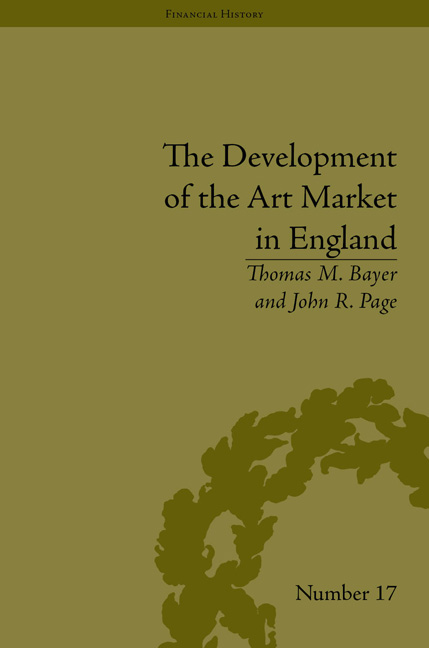Book contents
- Frontmatter
- CONTENTS
- Acknowledgements
- List of Figures and Tables
- Dedication
- Introduction
- 1 The Early Stages: From the Netherlands to Great Britain
- 2 The Commoditization of Theories of Art
- 3 The Painter as Homo Economicus
- 4 Critics and Auctions
- 5 The Evolution of Picture-Dealing
- 6 The Victorian Era
- 7 ‘Working the Oracle’: The Tools of the Trade
- 8 The Formation of a Nexus: A Story of Christie's
- 9 Commoditization and the Artist as Producer: Product Differentiation and the Domestication of Pictures
- 10 The End of the ‘Golden Age’
- 11 Postscript: A Perpetual Innovative Whirl
- Notes
- Works Cited
- Index
Introduction
- Frontmatter
- CONTENTS
- Acknowledgements
- List of Figures and Tables
- Dedication
- Introduction
- 1 The Early Stages: From the Netherlands to Great Britain
- 2 The Commoditization of Theories of Art
- 3 The Painter as Homo Economicus
- 4 Critics and Auctions
- 5 The Evolution of Picture-Dealing
- 6 The Victorian Era
- 7 ‘Working the Oracle’: The Tools of the Trade
- 8 The Formation of a Nexus: A Story of Christie's
- 9 Commoditization and the Artist as Producer: Product Differentiation and the Domestication of Pictures
- 10 The End of the ‘Golden Age’
- 11 Postscript: A Perpetual Innovative Whirl
- Notes
- Works Cited
- Index
Summary
Art follows wealth for its rich rewards.
Karel van Mander (1548–1606), SchilderboekThe simple truth is that capital is the nurse and governess of the arts; not always a very wise or judicious one, but an exceedingly powerful one.
P. G. Hamerton, Thoughts about Art (1871)These two astute remarks, though separated by nearly three hundred years, both tie the flourishing of the arts to money. Perhaps these seem rather obvious statements, because most artists need to exchange their products for either cash or goods in order to sustain their existence. However, both Karel van Mander and P. G. Hamerton assign to the arts a subordinate role. In one observation art follows wealth, in the other capital is the art's nurse and governess. Thus, to reap some of wealth's rich rewards art must follow the path wealth takes. However, art does not just simply follow money. Rather, the relationship between the two is reciprocal. The role of nurse implies caring and nurturing, while the role of governess suggests a formative influence. We note, too, the dates of these statements: both were made when profound changes in patronage were taking place or had already occurred in the Netherlands and England, the countries of these commentators. The traditional support of church, state and aristocracy had declined in favor of a growing middle class with increasing discretionary wealth.
- Type
- Chapter
- Information
- The Development of the Art Market in EnglandMoney as Muse, 1730–1900, pp. 1 - 12Publisher: Pickering & ChattoFirst published in: 2014



